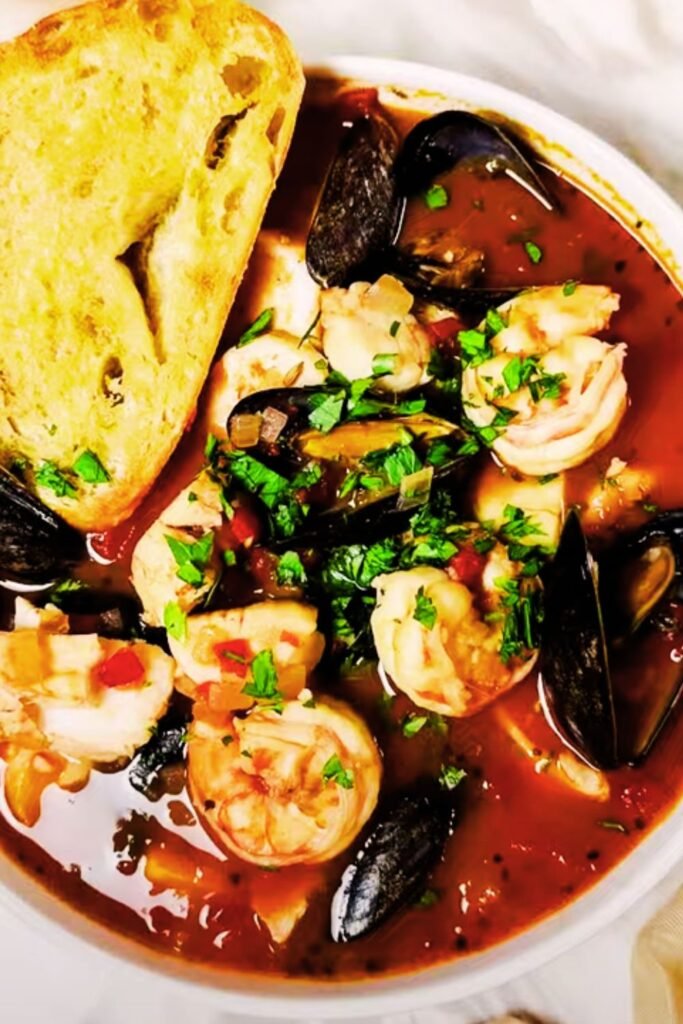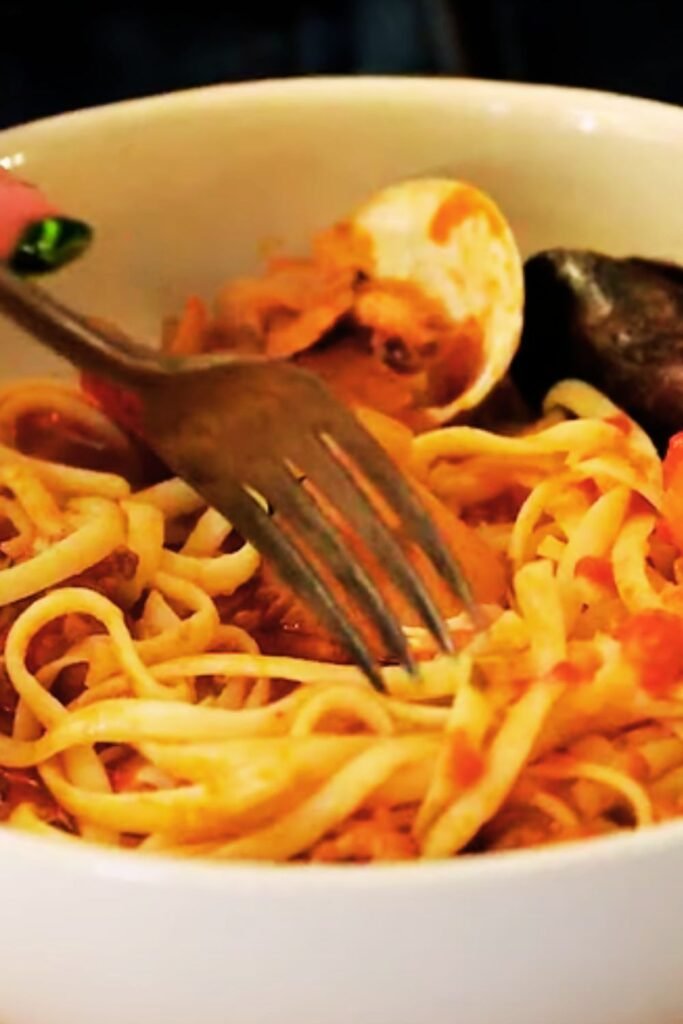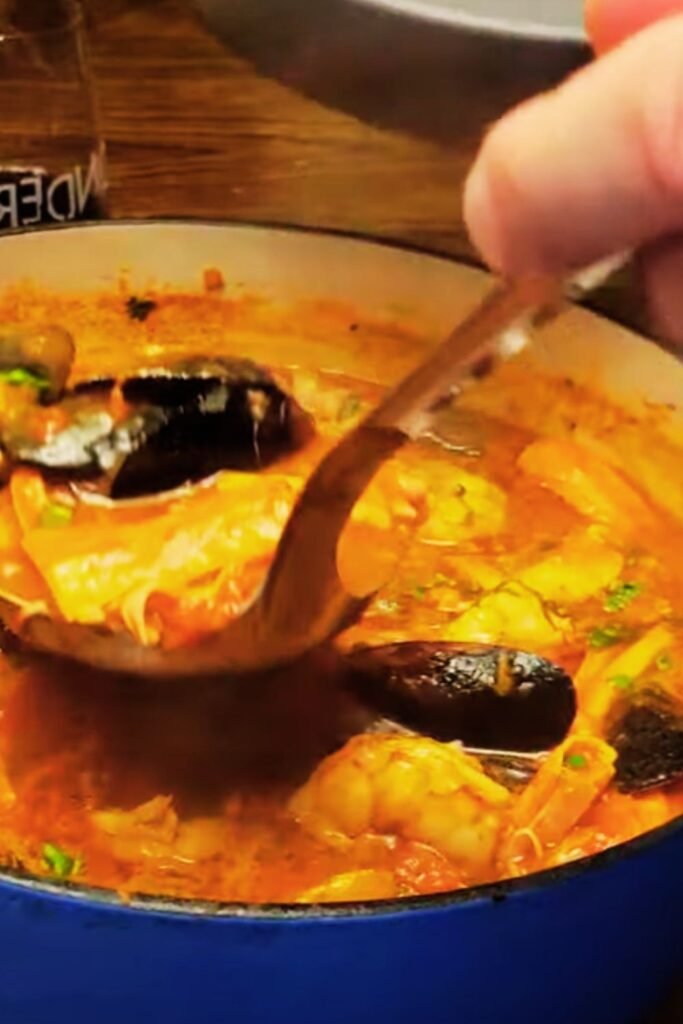There’s something magical about a steaming bowl of cioppino that instantly transports me to the bustling piers of San Francisco’s Fisherman’s Wharf. This iconic seafood stew, with its rich tomato-based broth and medley of fresh seafood, has been warming hearts and satisfying appetites for over a century. I’ve spent countless hours perfecting my version of this classic dish, and I’m thrilled to share my secrets with you.
Cioppino isn’t just a meal—it’s an experience. The aroma of garlic and herbs mingling with the essence of the sea creates an anticipation that’s almost as satisfying as the first spoonful. What I love most about this dish is its forgiving nature. Unlike many recipes that demand precision, cioppino embraces flexibility, allowing you to showcase whatever fresh seafood catches your eye at the market.
The Soul of San Francisco: Understanding Cioppino
Cioppino – A tomato-based seafood stew originating from San Francisco’s Italian-American fishing community in the late 1800s
Brodetto – The Italian predecessor to cioppino, a similar fish stew from the Adriatic coast
Soffritto – The aromatic base of sautéed onions, celery, and garlic that forms the foundation of the stew
Fumet – A light fish stock that can enhance the broth’s depth of flavor
The beauty of cioppino lies in its humble origins. Italian fishermen working the San Francisco Bay would create this stew using the day’s catch that couldn’t be sold—the “odds and ends” that transformed into something extraordinary. This tradition of using whatever seafood was available has become cioppino’s greatest strength, making it adaptable to any season or location.
Essential Ingredients for Perfect Cioppino
Creating memorable cioppino starts with selecting the right ingredients. I’ve learned through trial and error that quality matters more than quantity, and freshness trumps everything else.

The Seafood Foundation
| Seafood Type | Quantity (serves 6-8) | Preparation Notes | Best Substitutes |
|---|---|---|---|
| Dungeness Crab | 2-3 whole crabs | Pre-cooked, cracked | Blue crab, king crab legs |
| Large Shrimp | 1 lb (21-25 count) | Peeled, deveined | Prawns, langostinos |
| Mussels | 2 lbs | Cleaned, debearded | Clams, manila clams |
| Sea Scallops | 1 lb | Side muscle removed | Bay scallops (adjust cooking time) |
| White Fish | 1.5 lbs | Firm varieties | Halibut, cod, sea bass |
| Squid (optional) | 1 lb | Cleaned, cut into rings | Octopus tentacles |
The Aromatic Base
The soffritto forms the heart of my cioppino, and I never rush this step. The slow caramelization of onions, the gentle sizzle of garlic, and the bright pop of celery create layers of flavor that distinguish restaurant-quality cioppino from ordinary seafood stew.
Liquid Components
| Component | Amount | Purpose | Notes |
|---|---|---|---|
| Crushed tomatoes | 28 oz can | Base flavor | San Marzano preferred |
| Tomato paste | 3 tablespoons | Depth and richness | Double concentrate works best |
| Dry white wine | 1 cup | Acidity and complexity | Sauvignon Blanc or Pinot Grigio |
| Fish stock | 4 cups | Seafood essence | Homemade preferred, low-sodium if store-bought |
| Clam juice | 1 cup | Briny depth | Bottled is acceptable |
My Foolproof Cioppino Method
After years of refinement, I’ve developed a technique that delivers consistent results every time. The key is building layers of flavor while respecting the delicate nature of seafood.
Step 1: Creating the Foundation
I start by heating olive oil in my largest, heaviest pot—a Dutch oven works perfectly. The oil should shimmer but not smoke. I add diced onions first, cooking them slowly until they become translucent and sweet. This patience pays dividends in the final dish.
Next comes the celery, followed by minced garlic. I’ve learned that garlic burns quickly, so I add it last and cook just until fragrant—about 30 seconds. The aroma should fill your kitchen without any bitter undertones.
Step 2: Building the Tomato Base

I stir in tomato paste, cooking it for two minutes to eliminate the raw flavor. This step concentrates the tomato essence and creates a deeper, richer base. The paste should darken slightly and become fragrant.
The crushed tomatoes follow, along with oregano, basil, and a pinch of red pepper flakes. I let this mixture simmer for 15 minutes, stirring occasionally. The sauce should reduce slightly and develop a beautiful deep red color.
Step 3: The Wine and Stock Addition
Wine comes next—I pour it in and let it bubble vigorously for two minutes to cook off the alcohol. The smell should be bright and clean, not harsh. Then I add the fish stock and clam juice, bringing the mixture to a gentle simmer.
This is where patience becomes crucial. The broth needs 20-30 minutes to develop its full flavor profile. I taste and adjust seasonings, adding salt, pepper, and sometimes a touch of sugar to balance the acidity.
Step 4: The Seafood Symphony
The order of adding seafood determines the texture of the final dish. I start with the firmest varieties first:
- Firm white fish goes in first, cut into generous chunks
- Mussels follow, nestled into the broth
- Crab pieces are added next, shell-on for maximum flavor
- Shrimp cook quickly, so they go in during the final 3-4 minutes
- Scallops are the most delicate, requiring just 2-3 minutes
Each addition should be gentle—no vigorous stirring that might break apart the delicate seafood. I cover the pot between additions, allowing the steam to help cook the shellfish.
Timing and Temperature: The Science Behind Perfect Cioppino
| Seafood Type | Cooking Time | Internal Temperature | Visual Cues |
|---|---|---|---|
| White Fish | 8-10 minutes | 145°F | Flakes easily, opaque |
| Mussels | 5-7 minutes | N/A | Shells open wide |
| Crab | 3-5 minutes | 145°F | Heated through |
| Shrimp | 3-4 minutes | 145°F | Pink and curled |
| Scallops | 2-3 minutes | 145°F | Firm, slightly translucent center |
Temperature control is critical. I maintain a gentle simmer throughout the cooking process—vigorous boiling will toughen the seafood and cloud the broth. The surface should barely bubble, with small bubbles breaking gently rather than rolling aggressively.
Flavor Enhancement Techniques
Through years of experimentation, I’ve discovered several techniques that elevate cioppino from good to extraordinary:
The Saffron Secret
A pinch of saffron threads, bloomed in warm broth, adds an ethereal flavor and beautiful golden color. I crumble the threads between my fingers and let them steep in a ladle of hot broth before stirring back into the pot.
Fennel Magic
Fresh fennel fronds, chopped finely, provide a subtle anise note that complements seafood beautifully. I add them during the last few minutes of cooking to preserve their delicate flavor.
The Parsley Finish
Fresh flat-leaf parsley isn’t just garnish—it’s an essential flavor component. I stir chopped parsley into the stew just before serving, reserving some for garnish. The bright, herbaceous notes wake up the entire dish.
Serving Suggestions and Presentation

Cioppino demands respect in its presentation. I serve it in deep, wide bowls that showcase the colorful seafood while containing the generous broth. The bowls should be warmed—cold ceramic will immediately cool the stew.
Bread Pairing
Crusty sourdough bread is traditional, but I’ve discovered that any artisanal bread with a sturdy crust works beautifully. The bread serves two purposes: soaking up the precious broth and providing textural contrast to the tender seafood.
Garnish and Finishing Touches
- Fresh parsley, chopped
- Lemon wedges for brightness
- Extra virgin olive oil drizzle
- Freshly cracked black pepper
- Red pepper flakes for heat lovers
Storage and Leftover Magic
Cioppino is one of those rare dishes that improves with time. The flavors meld and deepen overnight, though the seafood texture will change slightly. I store leftovers in the refrigerator for up to two days.
Reheating Guidelines
| Method | Temperature | Time | Notes |
|---|---|---|---|
| Stovetop | Low heat | 10-15 minutes | Gentle stirring, don’t boil |
| Microwave | 50% power | 2-3 minutes | Stir halfway through |
| Oven | 300°F | 20 minutes | Covered, in oven-safe bowl |
Nutritional Benefits and Dietary Considerations
Cioppino is surprisingly nutritious, packed with lean protein, healthy omega-3 fatty acids, and antioxidants from tomatoes. A typical serving provides approximately 35-40 grams of protein with relatively few calories.
Nutritional Breakdown (per serving)
| Nutrient | Amount | % Daily Value |
|---|---|---|
| Calories | 320-380 | 16-19% |
| Protein | 38g | 76% |
| Carbohydrates | 15g | 5% |
| Fat | 12g | 18% |
| Sodium | 980mg | 43% |
| Vitamin C | 25mg | 28% |
| Iron | 3.2mg | 18% |
Troubleshooting Common Issues
Even experienced cooks encounter challenges with cioppino. Here are solutions to the most common problems I’ve encountered:
Overcooked Seafood
Prevention is the best cure. If seafood becomes rubbery, reduce cooking time next time. For immediate relief, remove overcooked pieces and add them back just before serving.
Thin Broth
If the broth lacks body, mix two tablespoons of tomato paste with a small amount of hot broth, then stir back into the pot. Simmer for 10 minutes to thicken.
Overly Acidic Flavor
A pinch of sugar or a splash of cream can balance excessive acidity. Add gradually and taste frequently.
Lacking Depth
If the flavor seems flat, check your salt levels first. Sometimes a squeeze of fresh lemon juice or a splash of good olive oil can brighten the entire dish.
Regional Variations and Personal Touches
While San Francisco-style cioppino remains the gold standard, I’ve encountered delightful variations throughout my culinary journey:
East Coast Adaptations
New England versions often include lobster and sometimes a touch of cream. The Italian-American communities in Boston and New York have their own interpretations, sometimes including pasta.
Mediterranean Influences
Some cooks add olives, capers, or anchovies for a more intensely Mediterranean flavor profile. These additions work particularly well with the tomato base.
Spice Variations
Regional tastes influence heat levels. Some versions include jalapeños or chipotle peppers, while others stick to traditional red pepper flakes.
Seasonal Considerations
Cioppino adapts beautifully to seasonal availability. Spring might feature spot prawns and early peas, while winter calls for heartier preparations with root vegetables added to the base.
Spring Seafood Selection
- Spot prawns
- Fresh salmon
- Young mussels
- Pea shoots as garnish
Summer Abundance
- Local crab varieties
- Fresh herbs from the garden
- Vine-ripened tomatoes
- Zucchini blossoms
Fall Harvest
- Dungeness crab season begins
- Heartier fish varieties
- Fresh fennel bulbs
- Late-season tomatoes
Winter Warmth
- Stored root vegetables
- Preserved tomatoes
- Heartier preparation methods
- Warming spices
Questions and Answers
Q: Can I make cioppino ahead of time? I don’t recommend cooking the seafood ahead of time, as it becomes tough when reheated. However, you can prepare the tomato base up to two days in advance and refrigerate it. When ready to serve, reheat the base and add fresh seafood.
Q: What’s the best substitute for expensive seafood like Dungeness crab? Snow crab legs work wonderfully and are often more affordable. You can also use canned crab meat, though add it at the very end just to heat through. For a budget-friendly version, increase the amount of mussels and shrimp.
Q: How do I know when mussels are safe to eat? Mussels should open during cooking. Discard any that remain closed after cooking, as they may not be safe to consume. Before cooking, tap any open mussels—they should close. If they don’t close, discard them.
Q: Can I freeze cioppino? I don’t recommend freezing cioppino with seafood, as the texture becomes unpleasant. You can freeze the tomato base for up to three months and add fresh seafood when ready to serve.
Q: What wine pairs best with cioppino? A crisp white wine like Sauvignon Blanc or Pinot Grigio complements the seafood beautifully. For non-alcoholic options, sparkling water with lemon or a light herbal tea works well.
Q: How can I make cioppino less salty? If your cioppino turns out too salty, add a peeled, quartered potato to the pot and simmer for 10 minutes. The potato will absorb excess salt. Remove before serving. You can also add a splash of cream or a bit of sugar to balance the flavors.
Q: Is there a vegetarian version of cioppino? While traditional cioppino is seafood-based, you can create a “cioppino-style” stew using mushrooms, particularly king oyster mushrooms for their meaty texture. Add seaweed or kelp for ocean-like flavors.
Q: How do I prevent the seafood from becoming rubbery? The key is gentle cooking and not overcooking. Keep the liquid at a gentle simmer, not a rolling boil. Add seafood in order of cooking time needed, and remove the pot from heat as soon as everything is just cooked through.
Creating perfect cioppino is both an art and a science, requiring attention to detail while embracing the spontaneity that makes this dish so special. Each time I prepare it, I’m reminded of why this humble fisherman’s stew has captured hearts for generations. The combination of fresh seafood, aromatic vegetables, and rich tomato broth creates a symphony of flavors that transforms any meal into a celebration.
Remember, the best cioppino isn’t necessarily the most expensive or elaborate—it’s the one made with care, quality ingredients, and shared with people you love. Whether you’re preparing it for a special occasion or a cozy weeknight dinner, this magnificent stew will never disappoint. Trust your instincts, taste as you go, and don’t be afraid to make it your own.